ATLAS EXCLUSIVE: FINAL REPORT ON OBAMA BIRTH CERTIFICATE FORGERY CHANGE YOU CAN BELIEVE IN
(Courtesy of Atlas Shrugs)
Techdude delivers a final report that exceeds my wildest expectations. It is irrefutable, empirical evidence - Obama's birth certificate is a forgery. Why? Why a COLB (certificate of live birth) forgery? That is the question.
My deepest thanks and appreciation for Techdude's unwavering commitment to the truth despite the threats and harassment, the slashed tires and the dead animal on his porch.
Insofar as "techdude's" credentials, he is an active member of the Association of Certified Fraud Examiners, American College of Forensic Examiners, The International Society of Forensic Computer Examiners, International Information Systems Forensics Association - the list goes on. He also a board certified as a forensic computer examiner, a certificated legal investigator, and a licensed private investigator. He has been performing computer based forensic investigations since 1993 (although back then it did not even have a formal name yet) and he has performed countless investigations since then.
Here is his analysis:
Obama’s Birth Certificate – CHANGE you can believe in.
I have decided to leave out the low level technicalities and the how-to section of this report due to a lack of time and more importantly I want to get the facts out as quickly as possible. As some of you may or may not know some asshat decided to track me down and vandalize my car and hang a dead mutilated rabbit from my front door in a lame attempt to intimidate me from proceeding with releasing any details of my analysis. They did succeed in delaying the report by a few days but instead of deterring me they just really pissed me off. To their credit, if I had not taken a few days off from the analysis I would have missed the most damning piece of evidence – the remnants of the previous security border. So to the demented retard who slaughtered an animal to make a point – f*ck you and thank you. And because of the amazing number of violent psychopaths who seem to be drawn to this issue, I am not going to use or supply any details that can be used to identify the owners of the COLBS used in the analysis except for those which have already been publicly disclosed. If the owners want to come forward on their own that is entirely their decision. Now let’s get to the summarized report.
In questioned document analysis there are several methods for detecting forgeries – the most basic of which is to conduct a side by side evaluation of known good samples to compare against the questioned one and to use an alternate light source to highlight the changes in the color and density of the inks and paper. In the case at hand there are no questioned physical documents to examine so I used the same basic techniques modified for the digital age for use in computer forensic analysis.
The following analysis was conducted using various Hawaiian COLBS issued over a multi-year time frame ranging from 2001 through 2008 but this report will focus only on the results from the March 2007 through June 2008 certificates for accurately comparing against the KOS image purportedly printed by the Health Department of Hawaii in June 2007. I am only interested in comparing apples to apples as they say but I will touch on some of the other years for a brief comparative and observational analysis.
Since the image presented is a graphical image and not a physical certificate I made the concerted effort to track down known good certificates and certificates images to use for the analysis. Thanks to several individuals I managed to collect and review multiple images of certificates issued between 2001 through 2003 all of which bore an identical layout to the previous Decosta image which was issued during the same time frame. Several more certificate images and physical certificates were also sent to me of certificates issued between 2006 through 2008 directly by their respective owners. All of the 2006 through 2008 certificates bore an identical layout to one another. Several copies of the images were created to allow digital modifications to be made without altering the original images. MD5 and SHA1 signatures were generated for each of the images and their duplicates. The signatures of the duplicates matched against their originals and the original images were then moved to a separate protected directory on the server.
By separating the certificate issue dates into groups the pre-2006 certificates show a clearly different security border design than the more recent 2006 through 2008 design. There were no other visually detectible modifications to the layout of the certificates between all time frames aside from the additional change from the DATE ACCPETED to DATE FILED headings.
Image 1. 2001 – 2008 border patterns
All known good certificate images from all time frames examined shared an apparent identical layout and font. Each of the available un-cropped full certificate images, from all time frames, showed the security borders to be almost perfectly centered from left to right within the lower 2/3 rd portion of the 8 ½ x 11 inch page with all deviations off center being within 15 pixels. Measurements were taken from the top left, top right, bottom left, bottom right, center top, and center bottom of each images security border to the edges of the visible paper which appeared as hard edges with the top cover of the scanners creating whitespace.
Image 2. Measurements
The embossed seals and ink stamps in all of the pre-2006 images are clearly visible in the scans however none of the post-2006 seals or ink stamps are visible without extensive manipulation to the digital images. Even when scanning the physical post-2006 certificate in my possession using multiple resolutions and using multiple scanners I was also unable to produce an image which would allow the seal to show though the image. The ink stamps on the rear side were also not visible in the front side scans without digital modifications to the scanned images. My scans of the physical certificate also produced the same results using multiple resolutions and using multiple scanners.
The post-2006 COLBs were then compared against one another for a direct 1:1 comparison. Using copies of the images I digitally enhanced and modified the scans by removing only the hatch pattern background and then removing the merged information fields leaving just the raw document templates and saving them as a series of digital overlay templates. When the 2006 overlay was placed on top of the 2007 image they matched from corner to corner with some minor variations on the minute angle of the images. The fonts were observed to be in the same locations and of the same size and kerning. The procedure was then used with the 2006 overlay on top of the 2008 image. Once again, they matched from corner to corner with some minor variations on the minute angle of the images. The fonts were observed to be in the same locations and of the same size, style, and kerning. The 2007 overlay was then applied on top of the 2008 image. The 2007 and 2008 also matched from corner to corner with some minor variations on the minute angle of the images. The fonts were observed to be in the same locations and of the same size, style, and kerning. Having verified that all of the examined post-2006 certificates were identical in form and substance I then focused the rest of the analysis using the 2007 and 2008 COLB KOS image to pin the document into the middle of the known time frame.
Image 3. Overlays
The same measurement methodology was used against the full un-cropped KOS image and showed the security borders to be uncentered from left to right within the lower 2/3 rd portion of the 8 ½ x 11 inch page with a deviation from the other measurements off center being the average of 75 pixels – a 60 pixel greater deviation. Measurements were taken from the top left, top right, bottom left, bottom right, center top, and center bottom of each images security border to the edges of the visible paper which appeared as hard edges with the top cover of the scanners creating whitespace. The differences are also detectible visually without the use of digital enhancements.
Image 4. measurement comparisons
The previously created overlays were placed on top of the image. When the 2007 overlay was placed on top of the image they did not immediately line up. After being matched from security border corner to security border corner with some minor variations on the minute angle of the images the security border pattern obviously did not match in pattern or in color. The fonts were observed to not be in the same locations and they also did not share same kerning. The procedure was then used with the 2008 overlay on top of the KOS image. Once again when the 2008 overlay was placed on top of the image they did not immediately line up. After being matched from corner to corner like the 2007 overlay again with some minor variations on the minute angle of the images the security border pattern obviously did not match in pattern or in color. The fonts were observed to not be in the same locations on the page and they also did not share same kerning.
Image 5. with 2007 and 2008 overlays
A direct relative comparison using unmodified copies of the original images were made in regards to the security border pattern and color. Several distinctions were noted from the 2007 / 2008 certificate security border versus the security border used in the KOS image.
Image 6. Border comparisons
Direct relative measurements using unmodified copies of the original images were made in regards to the font size and kerning. Several letters were distinctly different in width and kerning from the 2007 / 2008 certificate font versus the font used in the KOS image such as O, H, N, R, and C.
Images 7 – 9. Animated GIFs showing kerning differences
The metadata and EXIF information was then extracted from the 2007, 2008, and the two images. The metadata extracted from the JPG files consisted of the quantization tables used for compressing the image and the EXIF data if it was present.
The 2007 image’s rate of compression was calculated to an approximated 75% quality factor at 300 dpi with an image size of 2550 x 3300 pixels in a portrait orientation and contained no EXIF data.
The 2008 image’s rate of compression was calculated to an approximated 80% quality factor at 300 dpi with an image size of 2550 x 3300 pixels in a portrait orientation and also contained no EXIF data.
The un-cropped image’s rate of compression was calculated to an approximated 90% quality factor at 300 dpi with an image size of 2550 x 3300 pixels in a portrait orientation and also contained the following relevant EXIF data:
[Software ] = Adobe Photoshop CS3 Macintosh
[DateTime ] = 2008: 06:12 08:42:36
[ColorSpace ] = 65535
[ExifImageWidth ] = 2550
[ExifImageHeight] = 3300
Raw Image Orientation = Portrait
Photoshop Save As Quality = [8]
Photoshop Save Format = [Progressive]
The cropped image’s rate of compression was calculated to an approximated 50% quality factor at 300 dpi with an image size of 2427 x 2369 pixels in a landscape orientation and also contained the following relevant EXIF data:
[Software ] = Adobe Photoshop CS3 Macintosh
[DateTime ] = 2008: 06:12 08:42:36
[ColorSpace ] = 65535
[ExifImageWidth ] = 2427
[ExifImageHeight] = 2369
Raw Image Orientation = Landscape
The 2007, 2008, and the two KOS images were then analyzed by creating a heat map showing where each pixel changes as jpeg quality decreases from 100 to 0. A change was considered relevant once the sum of the changes to the red, green, and blue values exceeded 10%. The heat map created from the 2007 and 2008 images showed the fonts, seal image, and security border are all identical consistent values. To eliminate any subjective presumptions and to increase the number of comparative tests the same analysis was then conducted on the 2006 and prior certificate images which all found the fonts, seal images, and security borders to also be saved with identical consistent values. The same analysis on the KOS images showed the security border having a substantially different RGB quality value than the fonts and the seal image.
Image 10. RGB value heat maps
Image 11. Detailed images of RGB value heat maps
The 2007, 2008, and the two KOS images were also analyzed for jpeg compression variations by creating a heat map showing where the difference for a particular compression level is indicated. A change was considered relevant once the sum of the changes to the error level values exceeded 10% of the previously calculated compression error rates. The heat map created from the 2007 and 2008 images showed the fonts, seal image, and security border are all identical consistent values. To eliminate any subjective presumptions and to increase the number of comparative tests the same analysis was then conducted on the 2006 and prior certificate images which all found the fonts, seal images, and security borders to also be compressed with identical consistent values. The same analysis on the KOS image indicated that the security border has a different error value than the fonts and the seal image.
Image 12. Error level analysis heat maps
Image 13. Detailed images of error level analysis heat map
The image contains numerous visible artifacts located at various points throughout the image. These artifacts are not found on any other known good image from any examined time frame. I began creating a pixel level map of these errors by using a copy of the full un-cropped version and simply highlighting the areas by drawing a pixel wide line to the left and to the right of each visible flaw. The left side of the image towards the inside edge of the security border contained stray vertical lines that did not match up to any of the jpeg compression artifacts so they were highlighted. The right side of the image contained visual pixel level inconsistencies in the background hatch pattern. The right side pattern is visually consistent with the artifacts left after digitally erasing an area from an image and attempting to rebuild the background.
Image 14. Some random flaws highlighted
By connecting the points together the original placement of what appears to be part of the original security border becomes apparent. The placement of the lines matches the expected location of a good security border based on the known placement from the known good certificates. The width and spacing of the highlighted areas also match a 1:1 scale overlay from a section of a known good security border.
Image 15. Connected lines
A close examination of the security border itself reveals several repeating inconsistencies. Among them is a “weak line” which repeats once after every second bold line and a slightly downward curving end point where a straight line should end. This pattern continues around the entire perimeter of the security border. Upon very close inspection portions of the security border also repeat every 240 pixels. By mapping this repeating pattern it becomes apparent that the pattern is laid out as a 240 x 240 pixel square that can be accurately extrapolated to the next position by simply counting 240 pixels. This type of tiling effect is commonly seen when an image has been modified by filling an area using an image editing application’s tile or pattern fill function.
Image 16. Mapped border pattern
During the course of my analysis several calls were made to various departments in the Hawaiian State Government in an attempt to better understand the process and procedures used to create, print, and distribute copies of the COLB form. While I was brushed off or hung up upon by almost all of the people I contacted I did manage to talk with a computer technician who was familiar with the computers and printers used by the Department of Health and the clerk’s offices. He was unwilling to give any specific details but did provide enough information to work with. The COLB certificates are printed directly in the clerk’s office at the time they are requested. The system uses a standard laser printer and the border is printed at the same time as the text and other images on top of preprinted security paper. He stated the border is a vector image and would appear crisp and defined. When asked if a COLB can be printed off center he said it was not possible and any misfeed would simply jam in the printer. When asked if he had seen the images on-line he replied that he had – and that there is “no way” they had printed something that looked like that which further backed up my conclusions.
There are two obvious scenarios used to create the image that can be ascertained from evidence. Either a real COLB was scanned into Photoshop and digitally edited or a real COLB was first scanned to obtain the graphic layout then blanked by soaking the document in solvent to remove the toner. After rescanning the blank page to a separate image the graphics from the previously obtained scan could then be easily applied to the blank scan after some editing and rebuilding. It would also explain why date stamp bleeds through the paper and the various bits of toner located around the image as well as the remnants of the previous location of a security border.
So as I have been saying repeatedly since I first compared the KOS images to the Decosta image using the same tests and measurements – the image is a horrible forgery.
Previously at Atlas: FORENSIC EXPERT: "the [birth] certificate is still a horrible forgery"
Mystery, Clarification and Obfuscation of Obama's Birth Certificate Forgery
Atlas Tech Expert Declares Obama Birth Certificate ...
Who died and made him the final word on Obama's ...
The "Missing" Obama Birth Certificate Seal 6/29/08
SUCH A LIAR: OBAMA'S FAKE BIRTH CERTIFICATE 6/26/08
RELEASE OBAMA'S BIRTH CERTIFICATE! 6/10/08
****Must Cite Pamela Geller and link back to Atlas ****(play nice and honest).
UPDATE: Techdude added this in the comment section:
..some folks asked for it...so here are MORE screen shots. I uploaded a few from the 2001 and 2003 COLB tests and the animated gifs showing the fun pulsating kerning differences ala LGF style.
I assume no one has been able to figure out why the "2007" KOS image manages to have the same placement as a 2003 COLB and not a 2006, 2007, or 2008 COLB yet huh? How about the remnants of the previous border location? Humm...and what about that mis-matching uncentered border with obvious 2 pixel white spaces between the top and bottom headers? Any more novel theories? Space aliens? Right wing conspiracies? Oh I know...it must have all been a "satire" of a real one.
Decosta error level
2003 RGB Heat map
2007 on KOS animated - kerning differences
Animated gif - kerning differences
2003 over 2007
UPDATE: Israeli Insider weighs in here
UPDATE: lol
UPDATE: ACTION ALERT: ANY ATLAS READERS LIVE IN HAWAII? Reader Henry suggested we check the newspapers around the date of his birth in the vital statics area and see if they list his birth. Local libraries usually have old newspapers on microfiche. Depending on the newspaper, they might list the hopital as well as the time, date, parents. It won't tell us religion, color, Arab or African etc.... but it would verify his birthplace.

















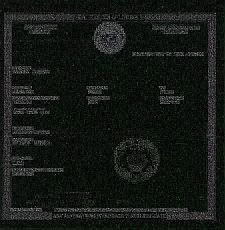
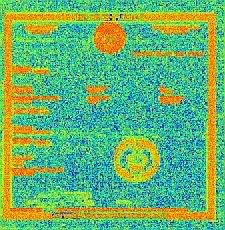
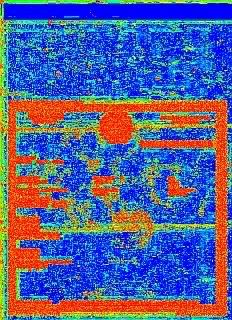


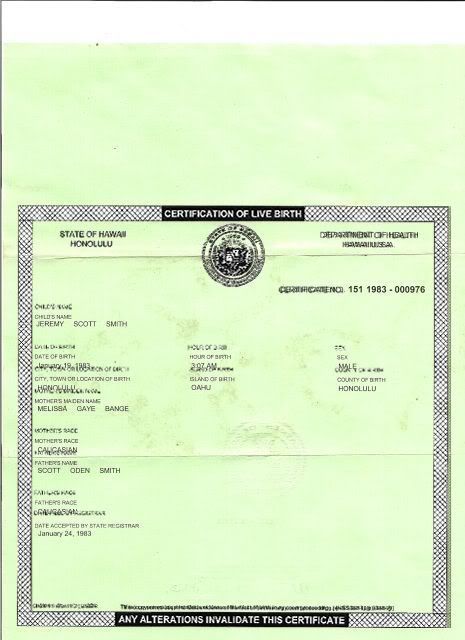
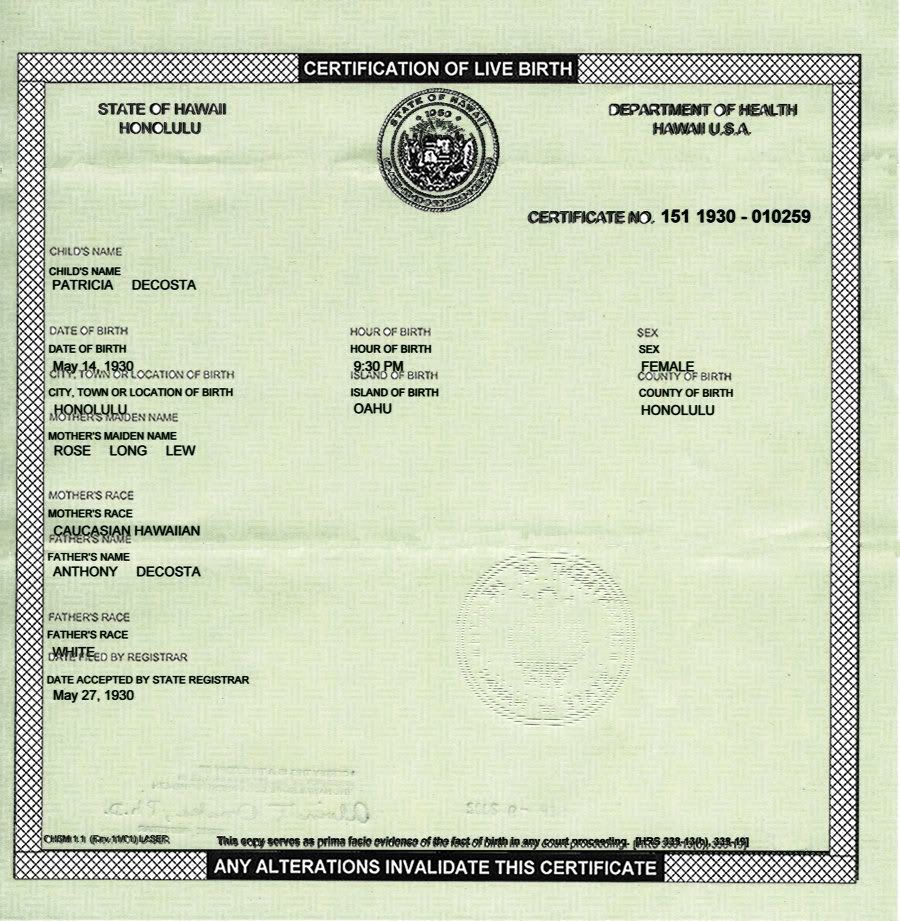











1 comment:
Funny how Nobama was in Hawaii and didn't settle this once and for all in getting a copy of his Birth Certificate while he was there.
I knew this was a forgery the minute I saw it. They put his father's race down as African. That is never done. In 1961 it would have been Negro.
Post a Comment